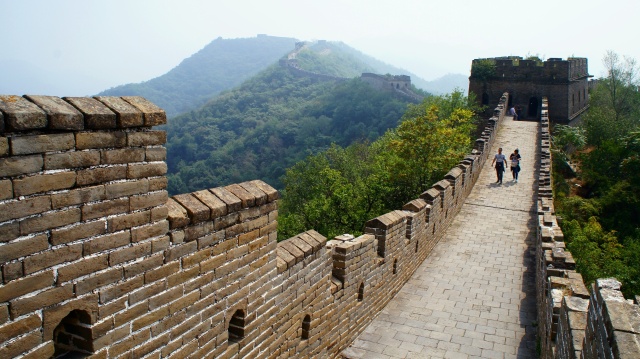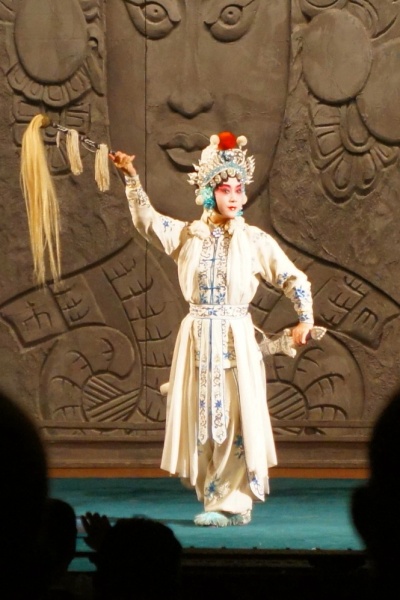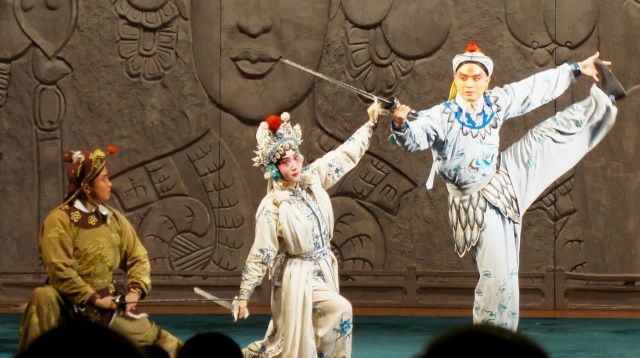Though I always wanted to see it, the Great Wall of China was not originally on my list of things to do in Beijing. I didn’t think I’d have enough time (the decent section of the wall takes around 2 hours to get to from Beijing) and wanted to better use the limited time I was allowed. However, when I was given a day off of work and was continually told how amazing the Wall is, I decided I should try to make the trek.
Thankfully that was made easy by the hostel I stayed at, who helped arrange day tours to the three sections of the Great Wall near the city.

Sections of the Great Wall near Beijing.
The three most popular tours from Beijing are to the Badaling section, which is the closest and apparently most touristy of them, the Jinshanling section, which involves a further drive and quite a bit of strenuous hiking, and the Mutianyu section, which is just about in the middle of both. That was the one I opted for.

Layout of the Mutianyu section
Me and a couple other people from my hostel left to join the tour bus in the early morning and journey in the infamous Beijing traffic for two hours. When we finally arrived and piled out, we were instructed where to meet for lunch and were taken to buy the cable car tickets to get up the summit. Though disappointed that this cable car fee wasn’t included in the price we had already paid for the tour, it was certainly welcome after we realized just how steep and long the climb to actually GET to the Great Wall was.
When we got to the top a couple minutes later, there were still some platforms to climb and signage to pass before actually ascending the Wall. But upon first sight standing on this massive structure, it was easy to see what makes it so amazing.
First, let me back up a few centuries though. Everyone knows of the Great Wall, most people have an idea of what it looks like, but what function did it actually serve? Though the Wall, which in its entirety is an impressive 13,171 miles (21,196 km) long, was built over many years in different dynasties, the first record of a large wall meant to protect from northern invaders was during China’s first unifying dynasty, the Qin dynasty, around 221 BCE. The wall was further extended and repaired during subsequent dynasties. During the Ming dynasty, starting in the 14th century, nomadic Mongolian tribes from the north further threatened the empire. As a result, more fortifications were created and some remaining packed earth walls were transitioned into stone walls. Beginning in the 1600s, the Manchus started to march south and the Wall became a vital source of defense for the Ming dynasty. It didn’t totally serve its function, however, and the Manchus ended up conquering Beijing, defeating the rebel-founded Shun dynasty and the ruling Ming dynasty, and establishing the Qing dynasty. Mongolia was annexed into the empire and the Wall was no longer needed for defense purposes.
The Great Wall, though seen in a much more functional context for people from China, soon became a source of myth and legend for foreign travelers. Traveler records as early as the 14th century mention it, and after the opening of the country after the First Opium War, it became a popular destination for non-Chinese tourists. It was in these documentations of the Wall that the the grandiose and romantic notion of the site were perpetuated. Ironically, the famous saying that the Great Wall is visible from the moon was first written in 1754, over 200 years before man would actually step foot on the moon!
It has been confirmed many times that it is in fact, not visible from space, probably owing to the fact that the Wall is only a maximum of 9 meters wide and usually is approximately the same color as the surrounding landscape. In 1987, at the 11th World Heritage Committee meeting, the Great Wall of China was inscribed as a World Heritage Site under criteria (i), (ii), (iii), (iv) and (vi), which if you know about World Heritage is quite significant indeed.
Needless to say, the Great Wall of China is quite spectacular. So let’s continue on our journey. Let me warn you, however, there are a lot of pictures with me in them. Sorry about that, it was such a once in a lifetime opportunity, I couldn’t resist!
At first the day started quite hazy and smoggy, but after a short time the haze started to burn off and only the normal smog remained. At that time of morning there were some (I hesitate to say ‘a lot’ considering how many people there could be at a heritage site in China) people milling around the starting point of the wall, but as I headed off, there seemed to be less and less.
As I continued along, the sun started to burn hotter and the path wound from uphill to downhill and finally to a definitely steep.
I’ll admit I had to stop a couple times, carefully turn around and sit on the steps to catch my breath. That was okay though, as the view was still stunning. Along the way I passed some old men doing backbreaking repair work to the steps, their wooden packs sitting nearby and it made me realize, though many people I know are involved in legislation to ensure that heritage sites receive the proper care they deserve, and though I am hoping to also one day be involved in that process, it rarely comes to my mind just what that level of up-keep entails for the local people.
As well, at the very top of the precarious peak there were people selling souvenirs, water and attempting to hawk beer. I can’t imagine how they carry all that stuff up there everyday, especially in the scorching heat of summer. I almost was amazed enough to buy a $5 postcard… almost.
At that point, the “official” tourist section stops. There is a sign stating “Danger beyond this point”, but the path was clearly renovated, and rocks had been placed in front of the sign, so I assumed that was a way of saying “Go for it!”
As I passed watchtower 21 and started for number 22, I realized a change. There were no more people. It was quiet, it was a bit windy and I was alone. One or two other people passed as I sat on the Wall resting my legs, but looking out at the landscape, which was slowly but surely being revealed through the burned-off haze, I was struck by what an immense effort not only of defending such a structure but of constructing it must have been! The huge expanse (and remember I only saw a very, very small section), high altitude and ancient technology at the time makes the building of the Great Wall truly one of the most impressive undertakings in human history. But I’m sure you already knew that. But really you can’t understand the magnitude of that truth until you stand on top of the Great Wall of China.
At that point I only had about an hour to make it back down the Wall, down the cable car and reach the restaurant where we would have lunch with the tour group. By then the sun was out and the surrounding mountains glowed green through the remaining haze (or maybe it was smog). 

One last look from the Wall. The bare looking piece near the end on the top is actually Chinese characters praising Chairman Mao.
After a nice lunch at the base of the mountain, we climbed back in the small bus and rode through traffic back to Beijing. When I returned to the hostel I had about 2 hours to spare until I had to leave again, so I enjoyed a dinner and some nice conversation in the common room. I had booked a ticket to watch the legendary Beijing Opera and was taken to a nice hotel south of Tienanmen Square which has a theater that specializes in Beijing Opera made easy for foreigners.
There is one thing to know about Beijing Opera (also called Peking Opera) and that is that it is an acquired taste. Many Westerners I have talked to tend to love the fabulous costumes but cringe at the “shrill” singing and generally don’t understand the myths and histories contained therein. The four main skills which are valued in actors of Beijing Opera are the speech, singing, dance-acting and combat movements. These skills are meant to be intertwining and the result performance must be beautiful above all else.
Here is a short video showing some basic elements of the Beijing Opera:
Also, as stages are usually extremely sparsely furnished excellent pantomime is necessary. According to Wikipedia:
Much attention is paid to tradition in the art form, and gestures, settings, music, and character types are determined by long held convention. This includes conventions of movement, which are used to signal particular actions to the audience. For example, walking in a large circle always symbolizes traveling a long distance, and a character straightening his or her costume and headdress symbolizes that an important character is about to speak. Some conventions, such as the pantomimic opening and closing of doors and mounting and descending of stairs, are more readily apparent.
As well, the singing and speech used by actors, though perhaps harsh for non-Chinese, was deliberately created in an effort to convey meaning. Different techniques of breathing and pronunciation were created specially for the Opera during its rise in the late 18th century and the music of the Beijing Opera is a very complex and formulaic art. Specially designated forms of speech (such as the shangchang, or “entrance speech”) are used to indicate placement and keep form within the story.
Numerous elements of Chinese acrobatics are also incorporated into productions and the resulting performers are then, clearly, those of extreme talent.

Before the preformance, an actor applied elaborate make-up on stage so people could watch the process.
Weirdly the actor who applied the make-up beforehand, and was helped to dress in the ornate costume seen at left, wasn’t in either of the performances we saw. The two pieces of opera, which were only scenes from two different operas, also had Chinese subtitles and English translations off to the side of the stage. Though the watered-down, for-foreigners version of the operas were slightly disappointing, I will admit I was glad for the explanations of what was happening.
As mentioned, though the performance was pretty great, the tourist version was not as great as it could have been. I hope to see another before leaving China and maybe this time spring for the real deal.
When I got back to the hotel I was understandably tired and went promptly to bed. The next day would be my last in Beijing and I wanted to be fit and awake to take it the monumental Tienanmen Square and the Forbidden City!
Until Next Time,
Chelsea
















That is a Great wall!